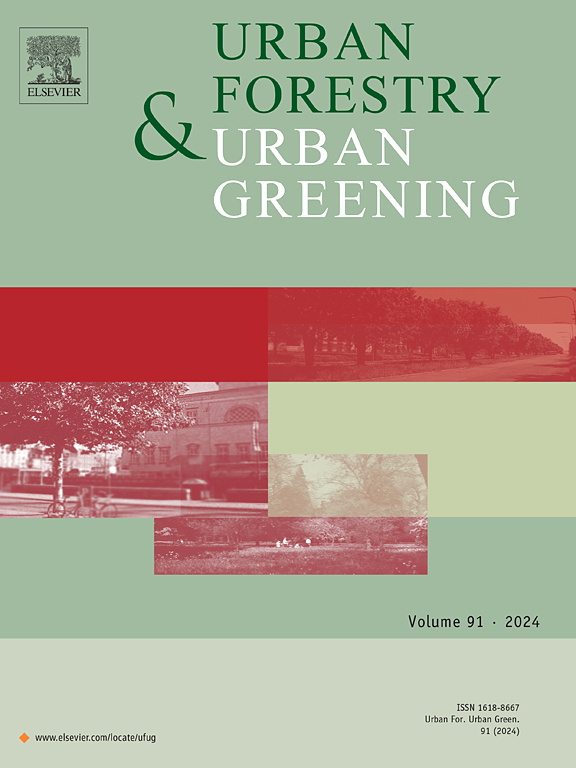在多个生态尺度上绘制城市景观图
IF 6.7
2区 环境科学与生态学
Q1 ENVIRONMENTAL STUDIES
引用次数: 0
摘要
在世界范围内,城市化正在加剧,推动了城市地区的扩张,并导致了栖息地的丧失、破碎化和环境条件的变化。尽管存在这些压力,城市景观仍然可以支持生物多样性,提供基本的生态系统服务,并有助于保护。有几个指标可以描述景观的特征,但它们的空间尺度取决于物种生态学或感兴趣的生态过程。罗马是欧洲最古老的城市之一,经历了几个世纪的持续城市化,同时保持了显著的绿化水平。本研究采用多尺度方法探讨了罗马的景观结构。我们分析了四个空间尺度(10 m、50 m、250 m和1250 m)的关键景观指标——绿地比例、边缘密度、香农多样性指数和边缘距离,这些指标与城市中各种动植物的生态有关。研究表明,这些景观指标可以分别用代表城市化和破碎化的两个主要轴来概括,并允许将罗马绿地分为三种类型(同质绿地、高度不透水区域和点缀着小绿地的不透水表面)。本研究生成的高分辨率栅格数据可以为测试这些轴线在不同尺度下以及由此产生的景观类型如何影响城市物种组合奠定基础本文章由计算机程序翻译,如有差异,请以英文原文为准。
Mapping the urban landscape at multiple ecological scales
Urbanization is increasing worldwide, driving the expansion of urban areas and resulting in habitat loss, fragmentation, and changes in environmental conditions. Despite these pressures, urban landscapes can still support biodiversity, provide essential ecosystem services and contribute to conservation. Several metrics exist to characterize landscapes, but the spatial scale at which they are relevant depends on species ecology or on the ecological process of interest. Rome, one of Europe’s oldest cities, has experienced continuous urbanization over centuries while maintaining a remarkable level of greenery. This study explores the landscape structure in Rome using a multi-scale approach. We analyze key landscape metrics—Green Area Proportion, Edge Density, Shannon Diversity Index, and Edge Distance—across four spatial scales (10 m, 50 m, 250 m, and 1250 m), which are relevant for the ecology of a wide variety of plant and animal organisms that occur in the city. We show that these landscape metrics can be summarized by two major axes representing urbanization and fragmentation, respectively, and allow for grouping Rome green areas into three types (homogeneous green areas, highly impervious areas, and impervious surfaces interspersed with small green spaces). The high-resolution raster data generated in this study can lay the foundation to test how these axes at different scales and theresulting landscape types can shape urban species assemblages
求助全文
通过发布文献求助,成功后即可免费获取论文全文。
去求助
来源期刊

Urban Forestry & Urban Greening
FORESTRY-
CiteScore
11.70
自引率
12.50%
发文量
289
审稿时长
70 days
期刊介绍:
Urban Forestry and Urban Greening is a refereed, international journal aimed at presenting high-quality research with urban and peri-urban woody and non-woody vegetation and its use, planning, design, establishment and management as its main topics. Urban Forestry and Urban Greening concentrates on all tree-dominated (as joint together in the urban forest) as well as other green resources in and around urban areas, such as woodlands, public and private urban parks and gardens, urban nature areas, street tree and square plantations, botanical gardens and cemeteries.
The journal welcomes basic and applied research papers, as well as review papers and short communications. Contributions should focus on one or more of the following aspects:
-Form and functions of urban forests and other vegetation, including aspects of urban ecology.
-Policy-making, planning and design related to urban forests and other vegetation.
-Selection and establishment of tree resources and other vegetation for urban environments.
-Management of urban forests and other vegetation.
Original contributions of a high academic standard are invited from a wide range of disciplines and fields, including forestry, biology, horticulture, arboriculture, landscape ecology, pathology, soil science, hydrology, landscape architecture, landscape planning, urban planning and design, economics, sociology, environmental psychology, public health, and education.
 求助内容:
求助内容: 应助结果提醒方式:
应助结果提醒方式:


